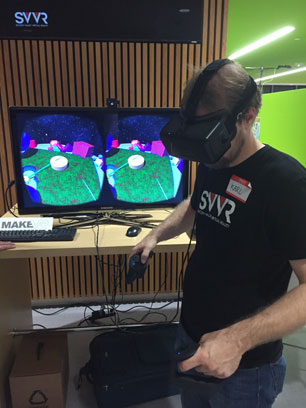Creating virtual worlds by hand should be as intuitive as stacking Lego bricks, sticking your fingers into clay, or chipping stone with a chisel. Artists should not, as they currently must, be required to take on the steep learning curve of an advanced 3D modeling tool. At the Silicon Valley Virtual Reality (SVVR) meetup this evening, I had the chance to try out a tool called MakeVR, which is currently being developed by Paul Mlyniec with Sixense.

I’ve known Paul for some 20 years now, and he has been dedicated to working with the concept of the two-handed interface all this time. It is a truly natural way of interacting with a virtual environment that allows you as the artist to interact with the very fabric of space just by reaching out and grabbing it.
Think of a 3D mouse in your hand, where you can “click & drag” not only objects in space, but the very space itself. Now imagine a second mouse in your other hand. By working the two in tandem, you can actually “walk” through space, spin it around, and even shrink yourself down like Antman just by pushing and pulling the world.
While the user interface is quite solid, the MakeVR tool is still in the late development phase, and only a very few artists have been able to work with it so far. But I am told that it is nearly ready for release and from what I’ve seen, it is a very promising tool that will allow artists to freely create virtual sculpture using both additive and subtractive processes. It will be exciting to see how this unique tool is made available to the artistic community and what range of works might be done with it.
Some high-level comparisons could be made to another virtual art tool that we have seen called Tilt Brush. They are similar in that each enables the artist to intuitively create a spatial work in “real-time” while immersed in a virtual environment. But while Tilt Brush is more of a painting tool, for making marks in the space around you, MakeVR works with solid geometric forms, which means the resulting sculptures could also be sent to a 3D printer so the results can exist in the physical world, as well as the virtual.
These are interesting times for virtual artists, and I will be looking forward to spending more time exploring these and other tools that will help shape how the next generation of works are created.

